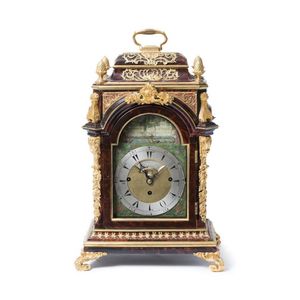18th Century Carillon and Bird Automaton Bracket Clock
You must be a subscriber, and be logged in to view price and dealer details.
Subscribe Now to view actual auction price for this item
When you subscribe, you have the option of setting the currency in which to display prices to $Au, $US, $NZ or Stg.
- Fusee - The fusee movement was used in clocks and pocket watches from the mid 17th century. The fusee is a cone shaped drum within the works that is linked to the barrel of the spring, usually by a length of chain.
As the mainspring loses its tension over time, the cone shaped barrel compensates for this by increasing the tension, by pulling the mainspring tighter, thus ensuring the time remains constant.
Use of the fusee in clocks was superseded by the "going barrel" in the mid 19th century and for pocket watches at the beginning of the 19th century.
The fusee continued to be used in marine chronometers until the 1970s. - Quarter Striking - A clock that srtikes on the quarter hour, as well as on the hour.
- Circa - A Latin term meaning 'about', often used in the antique trade to give an approximate date for the piece, usually considered to be five years on either side of the circa year. Thus, circa 1900 means the piece was made about 1900, probably between 1895 and 1905. The expression is sometimes abbreviated to c.1900.
- Movement - The technical name for the workings of a clock or watch, and does not include the dial or case.
- Carillon - A carillon in a clock or music box refers to a mechanism that plays a melody or a series of melodies on a set of bells or chimes. These bells or chimes are typically made of metal and are tuned to specific pitches to produce musical notes. The carillon mechanism is activated by the clock or music box's movement and can play a melody at specific intervals, such as hourly or on demand. A carillon clock or music box is a type of mechanical music box that is designed to play a melody on a set of bells or chimes.
- Back Plate - On many types of clocks, the movement operates between two plates, usually made of brass, one at the back, and the other at the front, which forms a mount for the dial.
On English bracket, mantle and table clocks the backplate was often visible through a glass door or panel from the late 17th century, and could be profusely engraved with scrolling decorations, flowers, foliage, birds, and figures. The engraving could also include the maker?s name.
The amount of engraving reduced and became simpler as the 18th century progressed, and by 1800, had been reduced to a border, often with the maker's name in the centre. By the early 1800s all decoration had ceased, and only the maker's name was added, and by the Victorian era, most bracket, mantle and table clocks had no engraving.
This item has been included into following indexes:
-
clocks, type
- automata / automaton 42
- bracket 328
Visually similar items

A Georgian bracket clock, the pagoda topped ebonized case with pine cone finials to the top corners and gilt metal figured and floral cast mounts to the front flanking the white painted arched face, with Roman numerals, strike/silent in the arch, seconds d

An English musical automata bracket clock, circa 1780, the ebonised case, with an inverted bell top, inset with four brass caryatids, and five acorn finials, engraved back plate, striking on eight bells, with fusee movement and pull repeat. Brass pierced s

A fine George III ormolu-mounted tortoiseshell veneered striking musical automaton table clock, made for the ottoman Market by Markwick Markham, London, triple fusee movement, verge escapement with a select lever at three on the side of the dial, each side

A fine Scottish George III bracket clock by James Nicoll Canongate Edinburgh, circa 1770. The double fusee bracket clock with verge escapement and pull repeat, housed within a black lacquer case with glazed sides and back, the bell top surmounted with bras
